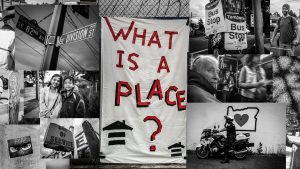Welcome to the Cultural Corridor Consortium (3C) portal! This portal is designed to be a resource for 3C communities. Please use this portal to learn about previous and existing 3C projects, access resources, submit content, and hear about upcoming opportunities.
About the Cultural Corridor Consortium
With generous support from the Kresge Foundation, T4A has partnered with communities across the U.S. to incorporate artistic and cultural practice into the planning and design of transportation projects, with a focus on leveraging these practices to expand transportation opportunities and local control for low income people, recent immigrants, and people of color living in disinvested communities. The Cultural Corridor Consortium (3C) aims to leverage these practices, which ultimately better serve communities, cultivate local champions, build local capacity, and reflect community culture and values. Through the 3C program, this approach avoids doing transportation work to or on communities, and instead supports a culture of investing in transportation projects in partnership with communities.
Cultural Corridor Consortium Cities
- 2017 – 2018: Dothan, AL; Indianapolis, IN; Los Angeles, CA; and Nashville, TN
- 2015 – 2017: Nashville, TN; Portland, OR; and San Diego, CA
(Nashville’s continued participation is supported by funding from ArtPlace America.)
Learn more about the 2017-2018 3C grantees on the T4A blog here.
Cultural Corridor Consortium peer learning
This portal is intended to be a platform for T4A’s Cultural Corridor Consortium network to learn from past 3C grantees, T4A staff and partners, while sharing challenges and lessons learned with their peer grantees. In addition to this portal, we will continue having bi-monthly calls and an in-person convening with T4A staff on April 5th, 2018 at Casa Azafran in Nashville, TN.
Desired outcomes
Through the 3C grant program, T4A aims to:
- advance artistic and cultural practice as a strategy that transportation agencies will adopt to strengthen community involvement in transportation decision making, facilitate productive community/agency meetings, and support community-driven infrastructure investments
- secure commitments from local transportation agencies and/or MPOs to adopt and develop creative placemaking programs
- plan and implement creative placemaking pilot projects in low-income corridors with planned transportation investments that serve as prototypes for future investments
- equip stakeholders to work across sectors to achieve shared goals
- strengthen local capacity to lead projects and continue creative placemaking and transportation projects after granting period
- support projects that have a place-based strategy, a defined geographic area (could be a single intersection, a multi-city region, or something in between), a clearly identified transportation challenge or opportunity, and a proposed artistic strategy to address the transportation challenge/opportunity
Participant Profiles
2017 – 2018 Cohort (Dothan, AL; Indianapolis, IN; Los Angeles, CA; and Nashville, TN)
(Nashville’s continued participation in the 2017-2018 Cohort is made possible thanks to funding from ArtPlace America.)
Dothan, AL
Dothan is a small southern city in lower Alabama (pop. ~68,000) with a retail and medical services hub-market serving over 600,000. Dothan has fallen victim to the adverse impacts of years of sprawl and auto dependency. The vast majority of the area’s recent transportation funds have been utilized solely for roadway construction and expansion,
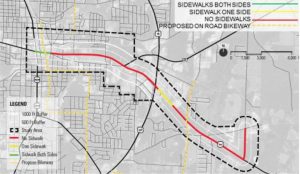 often out at the fringe of this small city. Dothan is not served by transit service, the city’s sidewalks — where they exist — are generally in poor condition, and there are no designated bicycle lanes. Furthermore, according to US Census Data, about 20% of Dothan residents live below the federal poverty line. Compounded by both struggling communities and auto dependency, those who walk or ride bicycles as a regular means of transportation face challenging and dangerous circumstances.
often out at the fringe of this small city. Dothan is not served by transit service, the city’s sidewalks — where they exist — are generally in poor condition, and there are no designated bicycle lanes. Furthermore, according to US Census Data, about 20% of Dothan residents live below the federal poverty line. Compounded by both struggling communities and auto dependency, those who walk or ride bicycles as a regular means of transportation face challenging and dangerous circumstances.
In close collaboration with the Wiregrass Museum of Art, Dothan’s first museum, the Dothan team intends to integrate arts and culture into the redevelopment of a four-mile segment of the Highway 84 corridor to address mobility, connectivity, and aesthetics to tell a story of their history, people, achievements, and future. As the Dothan team explained in their application, “the city will have an opportunity to shape a new and exciting development format which places livability at the forefront of how we utilize the built environment. It’s a format that makes possible the use of transportation corridors for alternative means of transportation, promotes active lifestyles, engages visual poetry in the design of infrastructure, streetscapes, and landscapes, and enables mixed-use developments that in-turn generate vibrant communities within the urban context.”
Indianapolis, IN
Indianapolis is hamstrung by an inadequate transit system that not only poorly serves those who depend on it, but makes talent retention and attraction a challenge for the region’s business community. According to a Brookings Institution report profiling transit in the country’s top 100 metro areas, while Indianapolis is the 14th largest city, it only boasts the 83rd largest bus fleet, and riders experience an average 60-minute wait time.
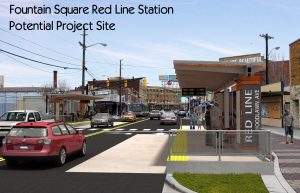
Improving that service has been a top priority for Indianapolis’s business community and many of the city’s elected, civic and faith-based leaders, who recognize that investing in transportation options is vital both for connecting low-income workers to economic opportunity and for the competition for talented workers and new businesses. Indy’s new transit expansion plan, paid for by voters through an income tax increase approved at the ballot in November 2016, will deliver a 70% increase in frequency and extend hours of operations, while also starting the construction of a bus rapid transit network to better connect Indianapolens to opportunity.
Transit Drives Indy (TDI), the 3C project team’s lead, is a coalition of businesses, organizations, and individuals whose collective-impact mission is to engage and educate around public transit. TDI aims to encourage, monitor, and facilitate the implementation of the new transit plan. TDI sees an enormous opportunity to create a new culture of public transit in Indianapolis by activating artists, communities, and arts partners through a multi-year creative placemaking program that integrates the arts into the design and implementation of the Marion County Transit Plan, specifically the 2019 opening of the Red Line, the first of the three planned all-electric bus rapid transit corridors. In addition to the Red Line, artists will play a critical role in the Purple Line Rapid Transit project, which is also headed by IndyGo, Indianapolis’ public transit agency. TDI and Arts Council of Indianapolis issued a call for artists for both bus plans with the goal of using creative strategies that embrace and include neighbors and businesses in the design process, inspire meaningful community dialogue, and connect communities to each other.
Los Angeles, CA
Hyde Park, one of the oldest communities in Los Angeles, is a working-class neighborhood (median income: $39,600) with relatively low levels of college education and many single parent households in the heart of African American L.A. While the neighborhood today lacks connections to the city’s growing network of rail lines, that will change as soon as the Los Angeles County Metropolitan Transportation Authority (Metro) is hard at work on the new Crenshaw-LAX (C-LAX) transit corridor that will connect Hyde Park (and Crenshaw Boulevard) to the Los Angeles International Airport, scheduled to open in 2019.
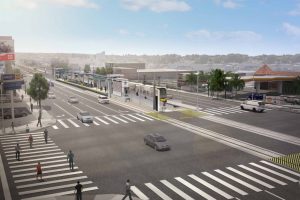
These direct connections to the airport and the rest of the city will provide Hyde Park residents with greater mobility, and employment and education opportunities. But in today’s climate where businesses and residents alike are clamoring to be in places that are well-connected to transit, real estate in close proximity to light rail will also become much more attractive to investors.
The real estate market is bigger than any one neighborhood and it’s hard to address the potential negative effects of gentrification block by block, but it’s crucial for local groups to lead the conversations and engagement around this topic. Through this grant, LA Commons will implement a process of gathering stories, led by a team of artists and local youth, who will ultimately transform them into an artistic intervention with high local resonance. LA Commons’ story gathering will have a strong equity lens, recognizing the key role that artists play in the community development process, providing an entry point for residents to envision an inclusive future, and to influence the policymakers in creating it. LA Commons will build community narratives by validating the importance of local voices, enhance the sense of belonging felt by a broad range of stakeholders, and encouraging stronger ties between the people and places of Los Angeles.
With Metro’s vision to create “transit-oriented communities” (TOCs), an approach to development focused on compact, walkable and bikeable places in a community context (rather than focusing on just a single development parcel), it’s critical to foster a community-based response to such investment during early planning phases that aligns with and highlights the unique assets and identity of the area. Using arts and culture, LA Commons will contribute to crafting these transit oriented communities around the new station.
Nashville, TN
In south Nashville, along the wide urban arterial of Nolensville Pike, lives a thriving community of immigrants and refugees primarily comprised of Latinx, Kurdish, Somali and Sudanese communities. Despite being home to the fastest growing immigrant community in the United States, Nolensville Pike, is a congested, auto-oriented, pedestrian-unfriendly arterial with eroded or non-existent sidewalks, few crosswalks, insufficient bicycle and pedestrian infrastructure, and no bus shelters, where travel outside of a car is unpleasant and often dangerous.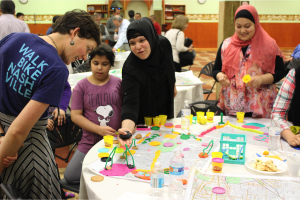
Led by Nolensville Pike-based organization Conexión Américas, community members of different ages and backgrounds worked together to design and build a temporary bus shelter to test ideas and start a conversation about improving transportation infrastructure, produce an oral history project in which high school students interviewed longtime residents about their memories and experiences with transportation, and run a month-long series of Creative Labs at which community members discussed, in culturally-specific settings, the assets and shortcomings of the Nolensville Pike corridor. These three projects are detailed in Envision Nolensville Pike, a plan for the arts-driven plan calling for the equitable redevelopment of the corridor’s transportation infrastructure.
With ArtPlace’s generous support, Conexión Américas will continue their inclusive community development efforts through a variety of projects, which includes transforming a car lot along Nolensville Pike into Azafrán Park, creating a Nolensville Pike Business Alliance, and collecting data to establish performance goals and track progress. Conexión Américas recommendations for preventing displacement in the Nolensville corridor and maximizing opportunities through Nashville’s Promize Zone, one of the area’s poorest neighborhoods, are outlined in Envision Nolensville Pike II.
Learn more about Nashville’s creative community engagement efforts on our blog here and in the video below:
https://www.youtube.com/watch?v=CXiqokhR0Eo
2015 – 2017: Nashville, TN; Portland, OR; and San Diego, CA.
Portland, OR
When roughly 14 miles of a bus rapid transit line was proposed along Division Street in East Portland, the effort was greeted with interest in an often-neglected area of the city, but also concern about the possibilities of displacement and development poorly engaged with the unique local culture. To address those concerns, community members throughout the Jade and Division Midway districts were engaged through arts and culture projects to recalibrate the plan to better serve community needs.
Arts-based engagement has helped build a positive dialogue between local agencies and the community to ensure that a new planned bus rapid transit line serves the residents of ethnically diverse, low income districts in the eastern part of the city. The Asian Pacific American Network of Oregon (APANO) and the Division-Midway Alliance, two nonprofits located respectively in the Jade and Midway districts along Division street in Portland, have been empowering residents, businesses, and students through arts and culture to actively shape the evolving Bus Rapid Transit (BRT) project.
This area is home to many immigrant and refugee families that give the area a rich ethnic and cultural diversity, yet it has historically lacked strong, safe transportation infrastructure. In a corridor with members from such diverse backgrounds, creative tactics allow the community to advocate, express, and communicate their desires and interests related to this new transportation proposal to ensure that the final project will best serve their communities’ needs, reflect what makes their community unique, and be embraced by the people and communities it serves.
To further build local capacity, the organizations built a placemaking steering committee comprised of eight civic, nonprofit, and government members to guide creative placemaking plans in the district, and ultimately strengthen coalitions. APANO also launched a creative placemaking project grant program, funding the creation of projects in the district led by cultural workers. These cultural workers then participated in a cohort known as the resident artist collaborative, in which they receive training to help prepare to produce community-engaged artworks.
By building public awareness and political pressure through arts and cultural projects, APANO and the Division-Midway Alliance helped to pause construction of the BRT planning process until the Portland Bureau of Transportation, mass transit agency TriMet, Metro, and others made formal Community Benefits Agreements and agreed to mitigation measures to ensure that the new vital transit service will transform the community in a positive way.
Learn more about APANO and Division-Midway Alliance’s creative approach to engagement in the Portland’s bus rapid transit line on our blog here and in the video below.
San Diego, CA
Since the mid-1990s, the neighborhood surrounding the intersection of 50th Street and University Avenue in the eastern City Heights neighborhood of San Diego has been a landing pad for newly arrived refugees from Somalia and other East African countries. Nearly three decades later, the bustling neighborhood, often referred to as as Little Mogadishu or Little Somalia, continues to serve the Somali and other East African communities. It’s a regional hub for other East Africans from throughout San Diego, a neighborhood hub for those that have been living there for years, and continues to be a welcoming home to new refugees. Many of those who arrived in the 1990s have become established business and community leaders, pillars of a strong local social fabric. In the neighborhood you’ll find Somali businesses, mosques that attract and support new arrivals, and affordable housing apartment complexes, all which contribute to the rich sense of culture and home.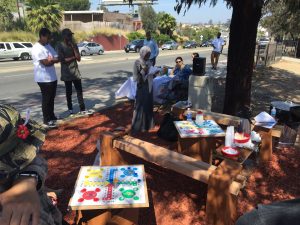
Despite the sense of community that the the neighborhood has nurtured, it’s a dangerous area to walk, with high rates of pedestrian fatalities and other safety issues. City Heights Community Development Corporation (CHCDC) has been engaging the community to envision how they can integrate their art, culture and history with a safer streetscape. Picking up on that work, Circulate San Diego, alongside CHCDC, initiated new programs to engage with largely East African and Somali residents to define community assets, and discuss how these assets can be reflected in art to improve the overall transit ridership experience with bus rapid transit on El Cajon Boulevard.
All of this public engagement has led to the development of parklets, gathering spaces, a pop-up coffee shop, local farmers market and traffic calming murals that have helped solidify sense of place, strengthened community ownership, and increased pedestrian safety.
The neighborhood’s “Take Back the Alley” mural project brought community members together to create a mural near a BRT station. This public art piece, and the positive effects it has on the surrounding area generated inertia, encouraging a small business owner nearby to clean up an adjacent parking lot and repurpose it as a café space, now leased by a local start-up coffee cart business.
Our partners also spearheaded the new San Diego Neighborhood Placemaking Collaborative, a collection of five neighborhood-based organizations who meet regularly to advocate for creative placemaking in the region. Last year, Circulate San Diego produced A Place for Placemaking in San Diego as a roadmap to overhaul the regulations and permitting policies that negatively impact creative placemaking projects in San Diego. The white paper is already helping to shape new permitting procedures by defining creative placemaking in San Diego’s Municipal Code and subsequently providing for a new process for community organizations and other applicants interested in pursuing neighborhood placemaking projects. Circulate San Diego and CHCDC also recently participated as key stakeholders in a city-led “Complete Boulevard study” to bring a complete streets design concept and creative placemaking elements to El Cajon Boulevard and this neighborhood in particular.
Learn more about San Diego’s work to promote safer streets and cultivate local ownership here and in the video below.
Directory
Dothan, AL
- Bob Wilkerson, Planner II, Long Range Planner, City of Dothan
- Dana Marie Lemmer, Director and Curator, Wiregrass Museum of Art
Indianapolis, IN
- Kelli Mirgeaux, Consultant, Transit Drives Indy
- Julia Muney Moore, Director of Public Art, Arts Council of Indianapolis
Los Angeles, CA
- Karen Mack, Founder & Executive Director, LA Commons
Nashville, TN
- Renata Soto, Co-Founder and Executive Director, Conexión Américas
- Alex Macias, Community Development Coordinator, Conexión Américas
- Rochelle Carpenter, Senior Policy Analyst, Greater Nashville Regional Council
Portland, OR
- Duncan Huang, The Asian Pacific American Network of Oregon
- Lori Boisen, District Manager, Division-Midway Alliance
- Dana Lucero, Senior Planner & Public Involvement Specialist, Oregon Metro
San Diego, CA
- Jim Stone, Executive Director, Circulate San Diego
- Anastasia Brewster, Active Transportation Coordinator, City Heights CDC
- Randy Van Vleck, Transportation and Planning Program Manager, City Heights CDC
Library
SGA & T4A Technical Resources
- Arts, Culture & Transportation: A Creative Placemaking Field Scan
- The Scenic Route: Getting Started with Creative Placemaking in Transportation
Completed 3C Art Plans
- Portland: Jade-Midway Districts Art Plan
- Nashville: Envision Nolensville Pike
- Nashville: Envision Nolensville Pike II
- San Diego: A Place for Placemaking
Additional Resources
- National Endowment for the Arts: How to do Creative Placemaking
- Gehl Institute: Makers on Market: Lessons from San Francisco’s Market Street Prototyping Festival
- American Planning Association: How Arts and Cultural Strategies Create, Reinforce, and Enhance Sense of Place
- Springboard for the Arts: Guide for Business Districts to Work with Local Artists
- Springboard for the Arts: Irrigate, artist-led creative placemaking toolkit
Forms
Please download the 3C Interim Report here and email your responses to Sophie Schonfeld by January 31, 2018.
Opportunities
Grant Opportunities
National Endowment for the Arts: Challenge for America
The Challenge for America Grant offers support primarily to small and mid-sized organizations for projects that extend the reach of the arts to underserved populations — those whose opportunities to experience the arts are limited by geography, ethnicity, economics, or disability. Age alone (e.g., youth, seniors) does not qualify a group as underserved; at least one of the underserved characteristics noted above also must be present. Please provide details about the underserved audience you select in your application. Grants are available for professional arts programming and projects that emphasize the potential of the arts in community development. This category encourages and supports public engagement with, and access to, various forms of excellent art across the nation to extend the reach of the arts to underserved populations.
Timeline:
- Submit SF-424 to Grants.gov – April 12, 2018
- Submit Materials to Application Portal – April 17-24, 2018
- Earliest Beginning Date for National Endowment for the Arts Period of Performance – January 1, 2019
National Endowment for the Arts: ArtWorks
The ArtWorks Design Grant supports public engagement with, and access to, various forms of excellent art across the nation, the creation of art that meets the highest standards of excellence, learning in the arts at all stages of life, and the integration of the arts into the fabric of community life. Projects may be large or small, existing or new, and take place in any part of the nation’s 50 states, the District of Columbia, and U.S. territories. NEA encourages applications for artistically excellent projects that: 1) celebrate America’s creativity and cultural heritage, 2) invite a dialogue that fosters a mutual respect for the diverse beliefs and values of all persons and groups, and 3) enrich our humanity by broadening our understanding of ourselves as individuals and as a society.
Timeline:
- Submit SF-424 to Grants.gov – February 15, 2018
- Submit Materials to Application Portal – February 20-27, 2018
- Earliest Announcement of Grant Award or Rejection – November 2018
- Earliest Beginning Date for National Endowment for the Arts Period of Performance – January 1, 2019
ArtPlace
Stay up to date with funding opportunities from ArtPlace through their newsletter (sign-up with your email address in the upper right hand corner here).
Citizens’ Institute on Rural Design
The Citizens’ Institute on Rural Design™ (CIRD) provides communities access to the resources they need to convert their own good ideas into reality. CIRD works with communities with populations of 50,000 or less, and offers annual competitive funding to as many as six small towns or rural communities to host a two-and-a-half day community design workshop. With support from a wide range of design, planning and creative placemaking professionals, the workshops bring together local leaders from non-profits, community organizations, and government to develop actionable solutions to the community’s pressing design challenges. The community receives additional support through webinars, conference calls, and web-based resources. Learn more about the application process here.
Timeline:
- Submit application – Friday, February 16, 2018, 5 PM EST
Conferences
The National Complete Streets Coalition is proud to partner with Transportation for America’s Arts & Culture team for our second national Complete Streets conference, Intersections: Creating Culturally Complete Streets, the premier convening of national leaders in Complete Streets and creative placemaking. Take part in the movement on April 3-4, 2018 at the Nashville Music City Center.
Nashville: Intersections & 3C Spring Convening
Intersections: Creating Culturally Complete Streets
This spring we will be having our 3C Spring Convening directly after Intersections: Creating Culturally Complete Streets, which is hosted by the National Complete Streets Coalition and the Arts & Culture team at Smart Growth America, in partnership with Urban Land Institute. The conference will begin with mobile workshops starting at 3 pm on Monday, April 2 and subsequently take place at Nashville Music City Center from Tuesday, April 3 through Wednesday, April 4. To view the full schedule for the conference, please visit our conference website page here.
Please reach out to Sophie Schonfeld to receive a promotion code to register for the conference or if you would like to register for a mobile workshop on Monday afternoon. For 3C grantee representatives and expert panelists, T4America has reserved hotel accommodations in downtown Nashville.
3C Spring Convening
On Thursday, April 5 after the conference, we will be having our 3C Spring Convening, which will include representatives from this year’s 3C cities: Nashville, Indianapolis, Dothan (Alabama), and Los Angeles. During the Spring Convening, representatives from each 3C city, T4America, the Kresge Foundation, as well as an expert panel will collaboratively discuss the projects, share challenges, and help guide the representatives in their projects aiming to incorporate artistic and cultural practice into the planning and design of transportation projects. This Spring Convening will take place at Casa Azafrán from 8:45 am – 3:00 pm. Please find additional details here: 3C Convening – Background & Agenda and fill out this travel form here.





